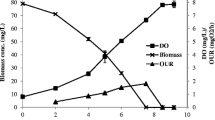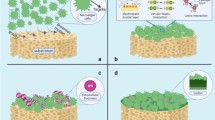Abstract
Removal of nitrogen and phosphorous by immobilized microalgae is an advantageous approach for wastewater treatment. Although immobilized microalgae cells remain viable to remove nutrients for several weeks, early leakage of cells because of deterioration of the capsules prevents further use of the immobilized microalgae. This study aimed at increasing the entrapment efficiency of Synechococcus elongatus by core-shell capsules of alginate (as the core) and 2-hydroxyethyl methacrylate (HEMA)-poly(ethylene glycol) methyl ether methacrylate (PEGMA) (as the shell). Cyanobacteria cells were immobilized into: 2 % alginate-1 % CaCl2, 2 % alginate-2 % CaCl2 and 4 % alginate-2 % CaCl2, and submerged into HEMA-PEGMA solution for: 1, 5, or 10 min. A liquid and transparent (93 % transparency) HEMA-PEGMA solution was obtained and used to form a shell over the alginate matrix. Capsules with a shell formed after 10 min of contact with HEMA-PEGMA increased four times (22 days) the cell entrapment efficiency relative to uncoated capsules, independently of alginate or CaCl2, while keeping cells metabolically active and able to remove nutrients.




Similar content being viewed by others
References
Aguilar-May B (2006) Inmovilización de células de la cianobacteria Synechococcus sp. para remover nutrientes de efluentes acuícolas. PhD Thesis. Departamento de Acuicultura. Centro de Investigación Científica y de Educación Superior de Ensenada. Ensenada Baja California, México.
Aguilar-May B, Sánchez-Saavedra MP (2009) Growth and removal of nitrogen and phosphorous by free-living and chitosan-immobilized cells of marine cyanobacterium Synechococcus elongatus. J Appl Phycol 21:353–360
Bailliez C, Largeau C, Berkaloff C, Casadeval E (1986) Immobilization of Botryococcus braunii in alginate: influence on chlorophyll content, photosynthetic activity and degeneration during batch cultures. Appl Microbiol Biotechnol 23:361–366
Bhattarai N, Ramay HR, Gunn J, Matsen FA, Zhang M (2005) PEG-grafted as an injectable thermosensitive hydrogel for sustained protein release. J Control Release 103:609–624
Billini M, Stamatakis K, Sophianopoulou V (2008) Two members of a network of putative Na+/H+ antiporters are involved in salt and pH tolerance of the freshwater cyanobacterium Synechococcus elongatus. J Bacteriol 190:6318–6329
Castro-Ceseña AB, Sánchez-Saavedra MP (2015) Evaluation of sodium tripolyphosphate-alginate coating and re-calcifying on the entrapment of microalgae in alginate beads. J Appl Phycol 27:1205–1212
Chávarri M, Marañón I, Ares R, Ibáñez FC, Marzo F, Virrarán MC (2010) Microencapsulation of probiotic and prebiotic in alginate-chitosan capsules improves survival in simulated gastro-intestinal conditions. Int J Food Microbiol 142:185–189
Cífková I, Stolt M, Holuša R, Adam M (1987) Calcification of poly(2-hydroxyethyl methacrylate)-collagen composites implanted in rats. Biomaterials 8:30–34
Covarrubias SA, Bashan LE de, Moreno M, Bashan Y (2012) Alginate beads provide a beneficial physical barrier against native microorganisms in wastewater treated with immobilized bacteria and microalgae. Appl Microbiol Biotechnol 93:2669–2680
Cruz I, Bashan Y, Hernández-Carmona G, de Bashan LE (2013) Biological deterioration of alginate beads containing immobilized microalgae and bacteria during tertiary treatment. Appl Microbiol Biotechnol 97:9847–9858
Dainty AL, Goulding KH, Robinson PK, Simpkins I, Trevan MD (1986) Stability of alginate-immobilized algal cells. Biotechnol Bioeng 28:210–216
Elvira C, San Roman J (1997) Complexation of polymeric drugs based on polyacrylic chains aminosalicylic acid side groups. J Mater Sci Mater Med 8:743–746
Fundueanu G, Nastruzzi C, Carpov A, Desbrieres J, Rinaudo M (1999) Physico-chemical characterization of Ca-alginate microparticles produced with different methods. Biomaterials 20:1427–1435
Guillard RL, Ryther JH (1962) Studies of marine planktonic diatoms I. Cyclotella nana Hustedt and Detonula confervacea (Cleve) Gran. Can J Microbiol 8:229–239
Gulsen D, Chauhan A (2006) Effect of water content on transparency, swelling, lidocaine diffusion in p-HEMA gels. J Membr Sci 269:35–48
Hach (1997) Water analysis handbook. Hach Company, Loveland
Henley WJ (1993) Measurement and interpretation of photosynthetic light responses curves in algae in the context of photoinhibition and diel changes. J Phycol 29:729–739
Hu Q, Westerhoff P, Vermaas W (2000) Removal of nitrate from groundwater by cyanobacteria: quantitative assessment of factors influencing nitrate uptake. Appl Environ Microbiol 66:133–139
Kowalska A, Stobiecka A, Wysocki S (2009) A computational investigation of the interactions between harmane and the functional monomers commonly used in molecular imprinting. J Mol Struct (Theochem) 901:88–95
Lau PS, Tam NFY, Wong YS (1997) Wastewater nutrients (N and P) removal by carrageenan and alginate immobilized Chlorella vulgaris. Environ Technol 18:945–951
Morachis JM, Mahmoud EA, Almutairi A (2012) Physical and chemical strategies for therapeutic delivery by using polymeric nanoparticles. Pharmacol Rev 64:505–519
Parsons TR, Maita Y, Lalli CM (1984) A manual of chemical and biological methods for seawater analysis. Pergamon, Oxford
Refojo MF, Yasuda H (1965) Hydrogels from 2-hydroethylmethyl methacrylate and propylene glycol monoacrylate. J Appl Polym Sci 9:2425–2435
Shibasaki-Kitawa N, Iizuka Y, Yonemoto T (2000) Intraparticle cell growth and cell leakage in cultures of Nicotiana tabacum cells immobilized in calcium alginate gel beads. J Chem Technol Biotechnol 75:1008–1014
Soni ML, Kumar M, Namdeo KP (2010) Sodium alginate microspheres for extending drug release: formulation and in vitro evaluation. Int J Drug Deliv 2:64–68
Taqieddin E, Amiji M (2004) Enzyme immobilization in novel alginate-chitosan core-shell microcapsules. Biomaterials 25:1937–1945
Tarté R (2009) Ingredients in food products: properties, functionality and applications. Springer, New York
Zainuddin Hill DJT, Whittaker AK, Lambert L, Chirila TV (2007) Preferential interaction of calcium ions in poly(2-hydroxyethyl methacrylate) hydrogels. J Mater Sci Mater Med 18:1141–1149
Zhang E, Wang B, Wang Q, Zhang S, Zhao B (2008) Ammonia-nitrogen and orthophosphate removal by immobilized Scenedesmus sp. isolated from municipal wastewater for potential use in tertiary treatment. Bioresour Technol 99:3787–3793
Zou XP, Kang ET, Neoh KG (2002) Plasma-induced graft polymerization of poly(ethylene glycol) methyl ether methacrylate on poly(tetrafluoroethylene) films for reduction in protein adsorption. Surf Coat Technol 149:119–128
Acknowledgments
This work has been funded by Consejo Nacional de Ciencia y Tecnología, CONACyT (Project: SEP-CONACyT 2009-01-130074), and Centro de Investigación Científica y de Educación Superior de Ensenada, CICESE (project No. 623108). A.B. Castro-Ceseña acknowledges her postdoctoral fellowship from CONACyT (Project No.: SEP-CONACyT 2009-01-130074).
Author information
Authors and Affiliations
Corresponding author
Rights and permissions
About this article
Cite this article
Castro-Ceseña, A.B., del Pilar Sánchez-Saavedra, M. & Ruíz-Güereca, D.A. Optimization of entrapment efficiency and evaluation of nutrient removal (N and P) of Synechococcus elongatus in novel core-shell capsules. J Appl Phycol 28, 2343–2351 (2016). https://doi.org/10.1007/s10811-015-0771-6
Received:
Revised:
Accepted:
Published:
Issue Date:
DOI: https://doi.org/10.1007/s10811-015-0771-6




